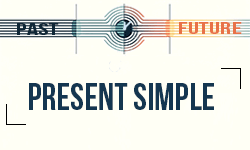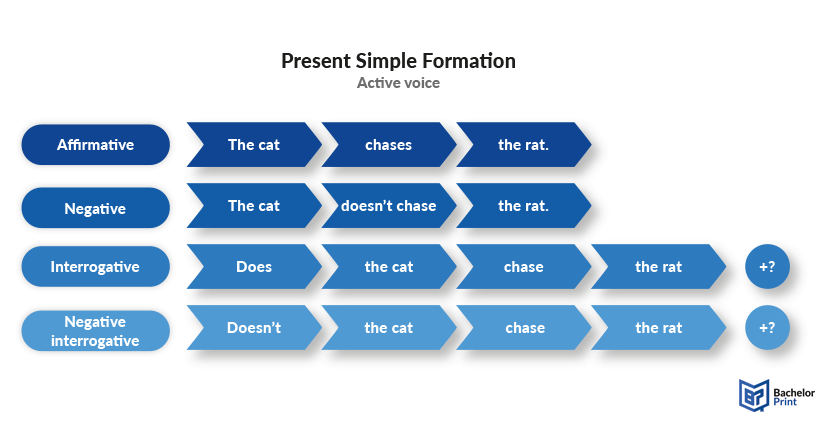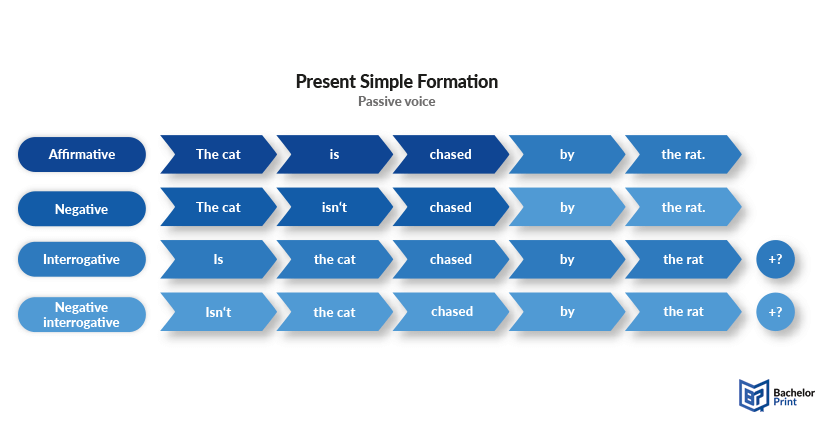
To master any language, one of the most important rules is learning how to form tenses. They establish the backbone of how we express time in communication. A basic, yet fundamental tense in the English language is the present simple, an essential component of our language rules used to describe habitual actions, general truths, and fixed arrangements. In this article, we will dive into the rules and usage of this tense, shedding light on how to apply it correctly in numerous contexts.
Definition: Present simple
The present simple (also: simple present) tense is a common verb tense used to describe habits, facts, fixed arrangements, and unchanging situations, such as jokes and stories. As the name already indicates, it is an elementary tense, as it is formed by using the base form or infinitive of the verb. However, when using he, she, or it, a special verb conjugation is needed.
Formula of present simple active voice
The present simple tense is one of the three simple tenses – which include past simple and future simple – and plays a fundamental part in the English language. This tense is characterized by its clear-cut structure that relies simply on the base form (infinitive) of verbs.
Even though it is an easily memorizable tense, pronouns or subject-verb-agreement need to be considered to use it correctly. The only mistake one can make when forming the present simple in active voice, is to forget the additional suffixes “-s,” “-es,” or “ies,” which are added to the verb when the named or unnamed subject is in the third-person singular. In this section, we will explore the rules and patterns involved in creating the present simple tense for both regular and irregular verbs by providing clear examples and explanations.
Regular verbs
Regular verbs of the present simple tense in third-person singular adhere to a predictable conjugation pattern. This means that you simply add an “-s” at the end of the root form of the verb.
In the table below, you can find more examples of regular verbs in 3rd person singular.
| Infinitive | Present simple |
| To dance | dances |
| To love | loves |
| To swim | swims |
| To stop | stops |
| To walk | walks |
| To work | works |
Irregular verbs
Most English verbs follow regular conjugation patterns, but there are a few irregular verbs that do not adhere to the standard rules. The concept of irregular verbs is more prominent in the past simple and past participle verb forms. However, in the present tense, the irregularities are seen in verbs that follow these patterns:
Structure
- If the verb ends in –o, –ch, –sh, –ss, –x, or you add “-es.”
- If the verb ends in a consonant and –y, you drop the -y and add “-ies.”
Below are several example sentences.
An example for each irregular verb pattern can be seen in the table below.
| Infinitive | Present simple |
| To cry | cries |
| To fix | fixes |
| To kiss | kisses |
| To mix | mixes |
| To spy | spies |
| To watch | watches |
Auxiliary verbs
Primary auxiliary verbs are essential in forming various tenses and questions. They consist of “to be,” “to have,” and “to do.” As expected, their conjugations are very different from other verbs, which also applies to the present simple tense.
| To be | To do | To have | |
| I | am | do | have |
| You | are | do | have |
| He/She/It | is | does | has |
| We | are | do | have |
| You | are | do | have |
| They | are | do | have |
Note: To emphasize something, we may use the auxiliary verb “do.” For example, instead of saying “I want to go out,” one could say “I do want to go out.” The same emphasis can also be achieved by using “really.”
We have combined all regular and irregular verbs in a PDF document that you can obtain by clicking on the download box below.
Practice worksheet
Now that you know how to form the affirmative present simple tense, it is time for your first exercise. Below, you can find ten example sentences that include regular, irregular, and auxiliary verbs in numerous contexts. Let’s test if you can get them all correct.
- They ____ football every Thursday and then ____ a film. (To play, to watch)
- My name ____ Hanna, and I ____ 25 years old. (To be, to be)
- His dad ____ the car once a month. (To wash)
- He occasionally ____ a foam bath. (To take)
- She ____ in Munich, Germany. (To study)
- You ____ to the Bahamas every year. (To travel)
- The company ____ many birthday gifts. (To produce)
- I ____ on the roof and ____ the sunset disappear. (To go, to watch)
- I ____ we can ____ in a better world. (To believe, to live)
- This ____ my new dog. You can ____ him if you ____. (To be, to pet, to like)
- They play football every Thursday and then watch a film. (To play, to watch)
- My name is Hanna, and I am 25 years old. (To be, to be)
- His dad washes the car once a month. (To wash)
- He occasionally takes a foam bath. (To take)
- She studies in Munich, Germany. (To study)
- You travel to the Bahamas every year. (To travel)
- The company produces many birthday gifts. (To produce)
- I go on the roof and watch the sunset disappear. (To go, to watch)
- I believe we can live in a better world. (To believe, to live)
- This is my new dog. You can pet him if you like. (To be, to pet, to like)
Active question form of present simple
To form yes or no questions in the present simple tense, we use the auxiliary verb “do” or “does,” with the latter being used in the third-person singular. It is then followed by the subject, the base form of the main verb, and a question mark.
Structure
Do/Does + subject + infinitive + rest of the sentence?
Examples
Note: One-word time expressions, such as “always,” “often,” and “usually” may be added between the subject and the verb.
Questions with question words
When a simple yes or no is not enough, we use question words that require more elaboration in their answers. Those question words are: what, where, when, why, who, how, how many, and how much. They are then followed by “do” or “does,” the subject, and the base form of the main verb.
Structure
Question word + do/does + subject + infinitive + rest of the sentence?
Examples
Negative question form of present simple
Negative questions in the present simple tense can be formed in two ways:
- Using “do not/does not” or its contraction “don’t/doesn’t.”
- Inverting the subject and auxiliary verb “do/does.”
Structure
Don’t/Doesn’t + subject + infinitive + rest of the sentence?
Do/Does + subject + not + infinitive + rest of the sentence?
The first question structure of present simple with the apostrophe is regularly used in spoken English and informal writing. It can convey a slight surprise or a need for confirmation of something the speaker believes to be true or is uncertain about.
The second question structure of present simple tends to be a bit more formal and is often found in written English. It emphasizes the negative aspect more clearly, which is typically used to indicate disbelief or surprise.
Note: The time expression “ever” may be added directly after the subject.
Negative questions with question words
When forming negative questions with question words in the present simple tense, the structure is the same, as you use “don’t/doesn’t” and the root form of the main verb.
Below, we have provided an image that contains the structures of the present simple active voice.

- ✓ 3D live preview of your individual configuration
- ✓ Free express delivery for every single purchase
- ✓ Top-notch bindings with customised embossing

Formula of present simple passive voice
Now that we have explained the structure of the present simple’s active voice in the previous paragraphs, it is time to talk about the form of its passive voice. Passive is used when the focus is on the action rather than on the doer of the action. It is formed with the help of the auxiliary verb “to be” in its present simple form and the past participle (3rd past form) of the main verb. When people are involved in a passive sentence, we use the agent “by” to show the subject of the action. Unlike with active voice, the object in a sentence becomes the subject of the passive sentence.
Structure
Subject + am/is/are + past participle + (by agent) + object.
Examples
Structure
Subject + isn’t/aren’t + past participle + (by agent) + object.
or
Subject + am/is/are + not + past participle + (by agent) + object.
Examples
Structure
Am/Is/Are + subject + past participle (+ by agent) + object?
Examples
Structure
Isn’t/Aren’t + subject + past participle (+ by agent) + object?
or
Am/Is/Are + subject + not + past participle (+ by agent) + object?
Examples
Note: There is no contraction for the first-person pronoun “I.” Therefore, English speakers use “aren’t” in informal contexts, e.g., “Aren’t I funny?”. However, for academic writing and other formal contexts, this is not acceptable, thus using “am not” is the preferred choice.
Below, you can find an image that summarizes the formula of the present simple passive voice.

Indicators for present simple
The English language has many tenses and for each one, there are time expressions that simplify figuring out which tense to use. Here are common indicators for the present simple tense, along with numerous examples.
Adverbs of frequency
They provide information about the regularity or repetition of actions and are commonly used with the present simple tense to indicate habitual or regular actions. They include words like always, usually, frequently, rarely, never, etc.
Daily/Weekly/Monthly activities
Refers to regular activities that are daily/weekly/monthly.
Specific days
Refers to specific days when habitual actions take place.
Short answers in present simple
Short answers in the present simple tense are concise responses that either confirm or deny the occurrence of an action or state, typically using auxiliary verbs. Here is how to form short answers in present simple, along with examples.
Active voice
Passive voice
Practice exercise
To wrap up this article, you can fill in the gaps for this last practice exercise. The correct answers for present simple conjugations are provided in the second tab. Mastering English tenses can be challenging, so have fun, and don’t worry if you don’t get everything correct the first time.
- The cake _____ my mum every Sunday. (To bake, passive)
- _____ she _____ the meeting regularly? (To attend, interrogative)
- The house _____ the maid every Monday. (To clean, passive)
- They _____ English every evening. (To study, active)
- The car _____ the mechanic twice a year. (To Service, passive)
- _____ you _____ your grandparents often? (To visit, interrogative)
- The project _____ on time by the team. (To complete, passive)
- He _____ the newspaper every morning. (To read, active)
- _____ the room _____ for the guests? (To prepare, interrogative)
- We _____ movies every Friday night. (To watch, active)
- The cake is baked by my mum every Sunday. (To bake, passive)
- Does she attend the meeting regularly? (To attend, interrogative)
- The house is cleaned by the maid every Monday. (To clean, passive)
- They study English every evening. (To study, active)
- The car is serviced by the mechanic twice a year. (To Service, passive)
- Do you visit your grandparents often? (To visit, interrogative)
- The project is completed on time by the team. (To complete, passive)
- He reads the newspaper every morning. (To read, active)
- Is the room prepared for the guests? (To prepare, interrogative)
- We watch movies every Friday night. (To watch, active)
FAQs
An example of present simple is the following:
- She walks to school every day.
The present simple form of a verb consists of the base form (infinitive) for all subjects except the third-person singular, which typically adds an “-s,” “-es,” or “-ies” to the base form. For example:
- I walk.
- He walks.
- I cry.
- He cries.
- She reads books in the evening.
- They play tennis on weekends.
- He works at a bank.
- We go to the gym every morning.
- The sun rises in the east.
- I drink coffee every morning.
- It rains a lot in April.
- She teaches English.
- They live in New York.
- He studies French.
The rule for present simple is to use the base form of the verb for all subjects, except the third-person singular (he, she, it), which adds an “-s,” “-es,” or “-ies” to the base form. This tense is used to express habitual actions, general truths, fixed arrangements, and scheduled events.
